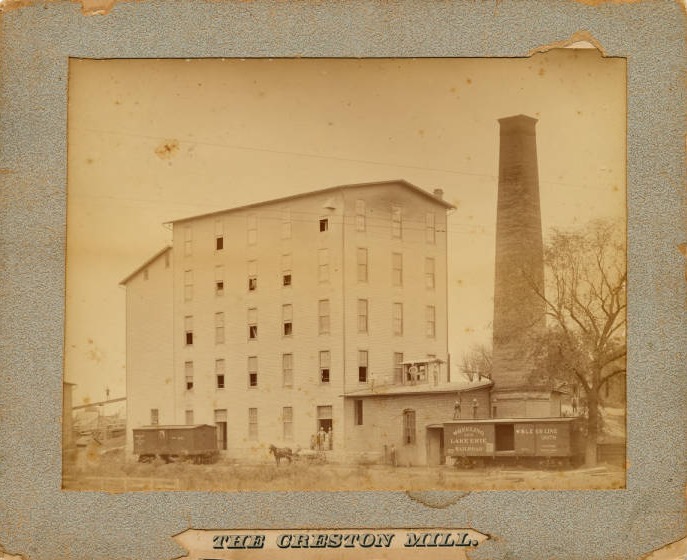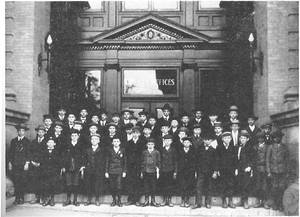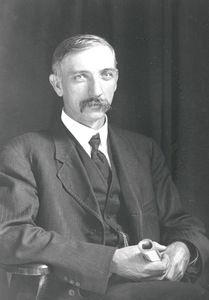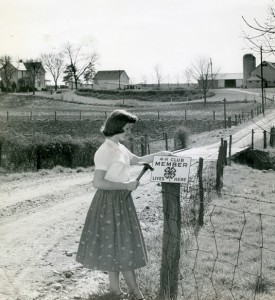Generation after Generation: Youth on Wayne County Farms and 4-H Clubs
- Home
- Agriculture and Sustainability
- Exhibits
- Generation after Generation: Youth on Wayne County Farms and 4-H Clubs
by Rachel Tomei, Revised by Glenna Van Dyke
Since the early twentieth century, 4-H clubs have been thriving social and educational programs in Ohio and Wayne County. Serving young people ages 5-19, 4-H has over 90,000 clubs nationwide. In Wayne County, whose 4-H programs are run by OSU, and across the country, members learn important life skills and become lifelong community members.
Farm Children in the Early Years
Farm life in the nineteenth and twentieth centuries was anything but easy. Farmers woke up before sunrise to work the land. Families relied on their crops and livestock to feed themselves and make a living, so each day was full of numerous tasks, and children were needed to help. Their jobs often included gardening, feeding the animals, or collecting eggs, although it varied from family to family. Older children were expected to work alongside their parents in the fields.

In the late nineteenth century, technology brought changes in farm life, especially for youth. Farming communities saw gaps in the rural education system, as schools prepared rural children for life in urban areas but failed to provide the resources that urban schools enjoyed. A.B. Graham, the superintendent of schools in Springfield, OH, noticed that more young people were moving to cites because of a lack of agricultural education. 4 Having grown up on a farm himself, he used his teaching experience and agricultural expertise to close this rural education gap. 5

The Birth of 4-H
On a cold January day in Springfield Ohio in 1902, A.B. Graham and a few children gathered in a dingy basement in the county building. 1 Though it looked unassuming, this was the first ever 4-H meeting and the beginning of a complete agricultural education. At this meeting, Graham gave each club member seeds and asked them to plant them and then carefully track their growth. 2 These club meetings sparked an interest in agriculture in these children, and they did many of the things modern 4-H clubs do now such as growing their own crops, conducting experiments, and sharing their results with each other. 3

Graham found support for his Boys and Girls Club from colleges with agricultural experiment centers such as Ohio State University, and The Ohio Agricultural Experiment Station, who were developing ways to share their findings with farmers.4 They realized that these young people in Graham’s club would be more likely to use new technology and methods on their farms. 5 Graham and his youth clubs became known state-wide, and in 1905 he was appointed the first director of extension by OSU.6 As director, Graham would help to establish extension offices across the nation.

Then, in 1914, Congress passed the Smith-Lever Act which created a national extension office network through the Department of Agriculture. 7 Soon after that, WWI struck and 4-H adapted along with the rest of the nation. 8 While helping with the war, 4-H’s purpose became more community oriented, and 4-H still holds true to this today. A few years later, in 1924, the clover and the name “4-H” were adopted. In the 50s and 60s, 4-H evolved as it strived to make 4-H accessible to all, moved into urban areas, and combined segregated 4-H chapters. 9 Today, 4-H still teaches millions of young people important life skills.

Beyond Expectations: 4-H Today
4-H today is still a thriving organization, and this is especially true in Wayne County. The county proudly has over 1,500 kids involved in over 50 active clubs with the second highest enrollment of adult volunteers.2 The clubs do a wide variety of projects, from turkey farming to model rocket building. 3 These more diversified projects encourage kids from more urban areas, such as downtown Wooster, to get involved. 4
Though 4-H has expanded since its founding, it has stayed true to its mission to get kids involved in agriculture. Kids still experiment on crops and help to raise animals that they then show at the Wayne County Fair. The fair and 4-H have a close relationship, and 4-H has its own junior fair board that helps to organize the event, and 4-H volunteers lead the cleanup effort afterward. 6
4-H clubs today would go beyond the wildest expectations of A.B. Graham or the OAES. Today, over 6 million kids learn important agricultural, leadership, and community engagement skills under the supervision of 100 different universities. 7 What started in Ohio as a humble youth club has turned into a nationwide organization that is fostering the next generation in and outside of agriculture.8
Sources by section
1 Gabriel N. Rosenberg, The 4-H Harvest: Sexuality and the State in Rural America (University of Pennsylvania Press, 2016), http://www.jstor.org/stable/j.ctt173zm92.
2 Oral Histories, 2010-2011 – Ariel Veroske and Whitney Siders, Oral history interview with Kurt Mairs, a Wayne County farmer, 2010, Oral History 4, Farmer Oral History Collection, http://openworks.wooster.edu/farmer_oral_history/4.
3 Sir Horace Plunkett, The Rural Life Problem of the United States (NewYork: Macmillion, 1910), 132; David B. Danbom, “Rural Education Reform and the Country Life Movement, 1900-1920,” Agricultural History 53, no. 2 (1979): 462–74.
4 Franklin M. Reck, The 4-H Story; a History of 4-H Club Work (Chicago: National Committee on Boys and Girls Club Work, 1951), 6, 9.
5 Ibid., 11-12.
1 Franklin M. Reck, The 4-H Story; a History of 4-H Club Work (Chicago: National Committee on Boys and Girls Club Work, 1951), 12.
2 “Twelve Days: 4-H Founder Helped Form Better Farmers for the Future, From Woody’s Couch, December 13, 2013, https://library.osu.edu/blogs/archives/2013/12/13/twelve-days-4-h-founder-helped-form-better-farmers-for-the-future/.
3 Ibid., “Wayne County 4-H | News and Notes!,” accessed June 25, 2017, http://u.osu.edu/waynecounty4h/.
4 R.E. Whitmoyer, A View From the Tower: A Collection of Historical Facts and Anecdotal Stories Covering the Early Years of the Ohio Agricultureal Research and Development Center (Wooster, OH: OARDC, 1992), 14; C. Cumo and R.E. Whitmoyer, Seeds of Change: A History of the Ohio Agricultural Research and Development Center (Wooster Book, 2000), 47, 57.
5 R.E. Whitmoyer, A View From the Tower: A Collection of Historical Facts and Anecdotal Stories Covering the Early Years of the Ohio Agricultureal Research and Development Center (Wooster, OH: OARDC, 1992), 14.
6 “Twelve Days: 4-H Founder Helped Form Better Farmers for the Future,” From Woody’s Couch, December 13, 2013, https://library.osu.edu/blogs/archives/2013/12/13/twelve-days-4-h-founder-helped-form-better-farmers-for-the-future/.
7 Reck, The 4-H Story, 118.
8 Gabriel N. Rosenberg, The 4-H Harvest: Sexuality and the State in Rural America (University of Pennsylvania Press, 2016), 165.
9 Ibid., 180-81.
1 Tami Lange Mosser, “4-H Is Good and Growing in Wayne County,” accessed June 23, 2017, http://www.woosterweeklynews.com/article/20140317/FEATURES/703179989/-1/wwn
2 Tracy Nider, “4-H Youth Devleopment 2016 Statistical Report” (ohio4h.org: The Ohio State University: College of Food Agricultural, and Environmental Sciences, 2016), https://osu.app.box.com/s/eoa08agj25dloadsqqia3jutxjbntowb, 16.
3 “4-H Project Information | OSU Extension | Wayne County,” accessed June 20, 2017, https://wayne.osu.edu/projectinfo.
4 Roxie Hammill, “4-H Appeals to Suburban Kids, Not Just Country Kids,” Kansascity, accessed June 22, 2017, http://www.kansascity.com/news/local/article52133625.html.
5 Mosser, “4-H Is Good and Growing in Wayne County”.
6 Ibid.
7 “History of 4-H Youth Development Organization,” 4-H, accessed June 12, 2017, http://4-h.org/about/history/.
8 Edmond P. Bowers et al., eds., Promoting Positive Youth Development: Lessons from the 4-H Study, Advancing Responsible Adolescent Development (Cham: Springer, 2015); Franklin M. Reck, The 4-H Story; a History of 4-H Club Work (Chicago: National Committee on Boys and Girls Club Work, 1951).
How to cite this page:
MLA: “.Generation after Generation: Youth on Wayne County Farms and 4-H Clubs” stories.woosterhistory.org, http://stories.woosterhistory.org/generation-after-generation:-youth-on-wayne-county-farms-and-4-h-clubs/. Accessed [Today’s Date].
Chicago: “Generation after Generation: Youth on Wayne County Farms and 4-H Clubs.” stories.woosterhistory.org. http://stories.woosterhistory.org/generation-after-generation:-youth-on-wayne-county-farms-and-4-h-clubs/ (accessed [Today’s Date]).
APA: (Year, Month Date). Generation after Generation: Youth on Wayne County Farms and 4-H Clubs. stories.woosterhistory.org. http://stories.woosterhistory.org/generation-after-generation:-youth-on-wayne-county-farms-and-4-h-clubs/
For More Information:
Wayne County 4-H Development Website (including “How to Join 4-H” in Wayne County)

